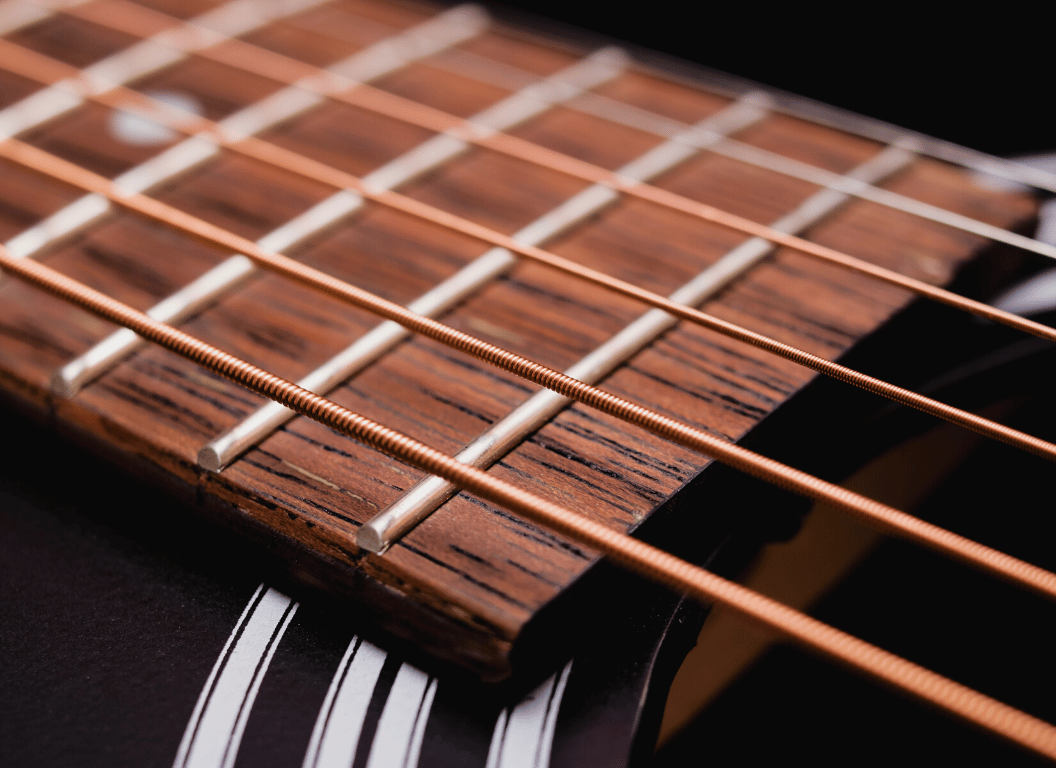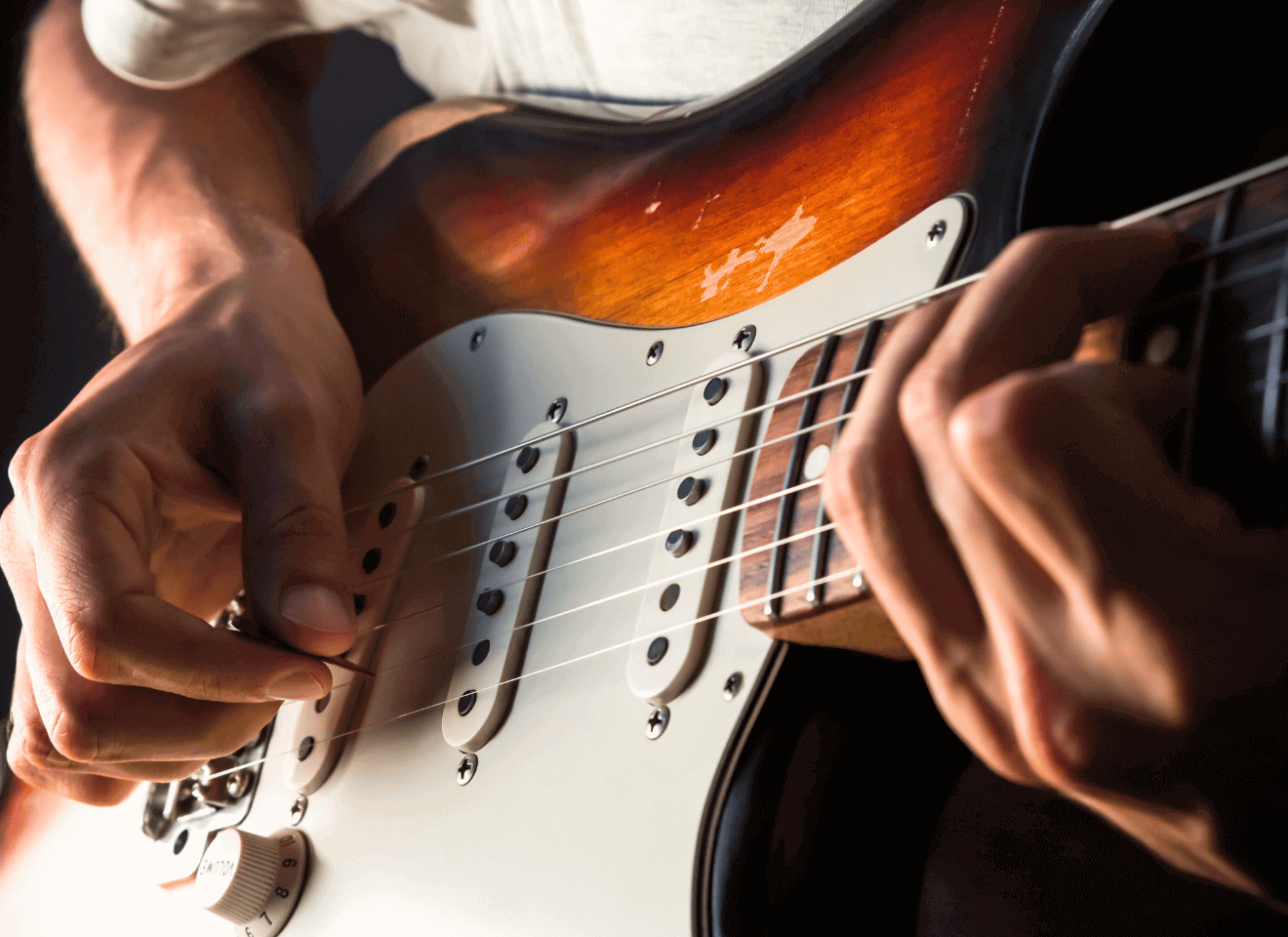Learning to play the guitar goes beyond just plucking its strings.
Mastering the individual notes on each fret is a critical aspect in becoming proficient with this instrument.
Unfortunately, for many beginners, the task of learning these notes can be a daunting challenge.
Some even give up before they truly start.
But what if there was a more accessible and less stressful way to uncover the guitar’s melodic secrets?
This article takes you through a simplified approach that will help you understand and learn the notes on a guitar effectively.
Table of Contents
- Guitar Notes | Learn The Notes On The Guitar In The Easiest Way Possible
- The Basics of Understanding a Guitar Fretboard
- Difference Between Open Strings and Frets
- Essential Steps for Learning Individual Notes on Each Fret
- Understanding Half-Step and Full-Step Increments in Pitch
- How Regular Practice Enhances Note Recognition
- Importance of Repetition in Learning Guitar Notes
- Quick Tips for Increasing Speed in Identifying Guitar Notes
- Exploring Common Mistakes Beginners Make
- The Bottom Line
Guitar Notes | Learn The Notes On The Guitar In The Easiest Way Possible
Learning the notes On The guitar in the simplest way involves understanding the fretboard, memorizing note positions, and practicing regularly. It is beneficial to start by learning the open strings (E, A, D, G, B, E) and then move up each fret which represents a half-step increment in pitch. Through continuous practice and repetition, guitar players can enhance familiarity with note positions resulting in quick identification and seamless play.
While the basics of understanding note positions and consistent practice are fundamental to learning the guitar notes, our discussion doesn’t end there.
We’ll delve into techniques to make memorization easier and explore strategies for note identification during actual play.
The subsequent sections are designed to equip you with a more comprehensive grasp of the subject matter.
Gain insights on chord structures, scale patterns, and the significance of the Circle of Fifths.
Whether you’re a beginner or an intermediate guitar player looking to enhance your skills, navigating through the next parts of this article will provide further important insights to bolster your guitar-playing journey.
The Basics of Understanding a Guitar Fretboard
For every aspiring guitarist, understanding the guitar fretboard is an integral part of mastering the instrument.
It is not just about learning how to hold the guitar or strumming the strings; it understandably goes beyond that.
The guitar fretboard is your musical playground as a guitarist, and the better you understand it, the more fluidly you can create beautiful melodies.
What is a Fretboard?
The term ‘fretboard’ or ‘fingerboard’ refers to the front part of the guitar neck, where we press down On The strings to change the pitch of the notes being played.
The horizontal metal strips that run across the fretboard are known as frets.
These frets divide the neck of the guitar into fixed segments at intervals related to a musical framework.
Understanding the fretboard enhances your ability to pick out notes and allows you to play more fluidly.
This quote elucidates the significance of knowing your fretboard.
By understanding the arrangement and musical relationship of the frets, you can significantly improve your comprehension of music theory.
Orientation of the Fretboard
When you hold a guitar in the traditional playing position, the headstock is to the left, the body to the right, and the six strings cross over the fretboard, which may seem rather confusing initially.
Each string is closer to a specific part of the body.
The vertical furthest string (low-E) is closest to your face, while the string nearest to the floor (high-E) is closer to your feet.
By watching the embedded video, you will gain a clear, visual understanding of the design and operation of the fretboard.
Furthermore, it offers practical exercises to help you memorize different fret placements and chords.
Differentiating Fretboard Notes
The guitar fretboard is composed of a series of notes, with each fret representing a different note.
These notes repeat in a pattern known as the ‘chromatic sequence,’ which repeats every 12 frets.
From open string, each consecutive fret increases the pitch of the string by one half-step.
After 12 frets, the sequence begins again, continuously repeating up the entire length of the fretboard.
The arrangement and understanding of these notes are paramount to making music On The guitar.
This emphasizes the importance of understanding the position, order, and musical relationship of different notes On The fretboard.
With diligent practice and a good grasp of the chromatic sequence, you will find yourself making beautiful music in no time.
Tuning and The Fretboard
A proper understanding of the fretboard also involves knowing how each string is tuned.
The string farthest from you when you hold the guitar in playing position is the low-E string, and it is generally tuned to the note E.
Subsequently, going down the guitar neck, the remaining strings are tuned to A, D, G, B, and high-E respectively.
Finally, understanding how the fretboard works are a great way to enhance your playing abilities and really get the most out of your guitar.
So keep practicing and make sure to incorporate some guitar theory into your routine to truly unlock your potential.
Difference Between Open Strings and Frets
In any discussion about guitar playing, it’s imperative to clearly understand the difference between open strings and frets.
Their unique properties have a significant impact on how the guitar sounds and how it is played.
Understanding Open Strings
When we talk about `open strings`, we are referring to playing a string On The guitar without pressing it down against a fret.
Open strings are the unfretted notes you can play on your guitar.
They produce a vibrant, resonating tone because they are allowed to vibrate freely from the guitar’s nut to the saddle when plucked or strummed.
Every guitar has six open strings which are usually tuned to the notes E, A, D, G, B, and E as the standard tuning.
Open strings are the unfretted notes you can play on your guitar and they produce a vibrant, resonating tone because they are allowed to vibrate freely from the guitar’s nut to the saddle when plucked or strummed.
It’s the fact that open strings vibrate freely that gives them their distinct and often resonant tone.
This is why they are often used to create chords and harmonies that are specific to the guitar.
Understanding and mastering open strings are essential for beginner guitarists because they form the foundation of many chords, melodies, and songs.
Clarifying Frets
When we shift the discussion to `frets`, we are talking about the raised elements you find On The guitar’s fretboard.
When you press down a string against a fret, you change the length of the vibrating part of the string, thereby altering the note it produces.
This is the principle behind all fretted notes on a guitar.
Each fret On The guitar represents a half-step increment in pitch which allows for the flexibility and versatility of the guitar in producing various notes and chords.
When you press down a string against a fret, you change the length of the vibrating part of the string, thereby altering the note it produces.
This is the principle behind all fretted notes on a guitar.
The ability to manipulate pitch in such a way is an integral part of playing melodies and complex chords On The guitar, making frets a crucial part of the instrument.
Frets allow musicians to play with musicality, precision, and expressiveness by giving them control over varying pitches.
It is through combining open strings and frets that guitarists can create a vast array of sounds and music.
An understanding of both these fundamental elements is a necessity for any aspiring guitarist.
Getting familiarity with both open strings and frets will not only improve your functional knowledge of the guitar anatomy but will also pave the way for efficient learning and better guitar playing.
Essential Steps for Learning Individual Notes on Each Fret
As you venture into your journey of learning to play the guitar, understanding the individual notes on each fret becomes increasingly important.
Novices often find the fretboard overwhelming due to the abundance of notes, but getting to grips with each individual note can simplify your learning significantly.
Start By Learning the Open String Notes
The first crucial step to mastering the fretboard is to familiarize yourself with the open string notes.
On a standard-tuned guitar, strings from the thickest to the thinnest are E (6th string), A (5th string), D (4th string), G (3rd string), B (2nd string) and E (1st string).
Knowing these notes inside out allows you to effectively navigate the rest of the fretboard.
Pay Attention to the Fret Notes
Once you become comfortable with the open strings, the next step is to learn the notes on each fret.
Remember that as you move up a fret on any string, the pitch of the note increases by a half-step.
Therefore, if you start On The Low E string (the 6th string), the first fret would be F, the second would be F#, the third G, and so on.
This pattern helps you in learning notes on all other strings as the logic remains the same: moving up a fret increases the pitch of the note by a half-step.
Gradually, you would be able to understand notes across the fretboard, equipping you with the foundation to embark on more complicated pieces.
Marking the Frets for Easy Identification
One popular technique beginners employ to memorize the guitar notes is by marking the frets.
Placing dots or stickers On The fretboard can act as visual cues for where each note is, speeding up the learning process.
However, the idea isn’t to rely on these markers perpetually.
They are merely aids to facilitate the initial learning process.
Over time, as your familiarity with the fretboard increases, you should wean away from these markers, eventually visualizing the notes in your mind.
Constant Practice and Patience
The process of learning guitar notes on individual frets requires regular practice and patience.
It might seem daunting at first, but constant repetition reinforces the knowledge, making it second nature for your fingers.
In time, you’ll realize that the effort and time you’ve put into learning these basic yet essential guitar concepts have laid a solid foundation for your journey as a guitarist.
Understanding Half-Step and Full-Step Increments in Pitch
One of the essential concepts when understanding the guitar fretboard is grasping pitch increments, specifically the half-step and full-step increments.
These increments, also known as semitones and whole tones respectively, essentially represent the distance between notes On The guitar.
What are Half-Steps and Full-Steps?
A ‘half-step‘ in music is the smallest distance between two different pitches in Western music.
In practical terms, on your guitar, moving one fret up or down represents a half-step.
Full-Steps: Doubling the Distance
Contrarily, a full-step requires moving two frets from the starting point on your guitar.
That is, if a note On The guitar is played at the first fret, playing a note a full-step away would mean moving to the third fret.
If a note On The guitar is played at the first fret, playing a note a full-step away would mean moving to the third fret.
This basic understanding of full-steps essentially doubles the distance covered in a half-step.
It plays a significant role in comprehending and constructing scales in music, making your exploration of the guitar fretboard more logical and systematic.
Understanding Half and Full Steps on a Guitar
In a broad sense, understanding these steps On The fretboard is an integral part of learning the layout of notes and being able to change keys smoothly.
This understanding is crucial, especially when playing chords and scales since these musical structures are simply combinations of half and full steps in varying patterns.
This insightful video provides practical tips and mnemonic devices to efficiently memorize the fretboard.
It guides you through exercises that help internalize the relationships between the notes and their positions On The fretboard.
Importance of Regular Practice
Like any other musical skill, understanding half-steps and full-steps cannot be achieved overnight.
Regular practice is the key to internalize this theoretical knowledge into practical application.
Regular practice is the key to internalize this theoretical knowledge into practical application.
A good tip is to take your time practicing scales and intervals On The fretboard using these steps.
As you master this, you’ll find that you can navigate the fretboard with much more ease and confidence, aiding your ultimate goal of seamless and musical guitar playing.
Conclusion
Understanding half-step and full-step increments in pitch is a critical component of music theory that applies directly to the guitar.
While initially it may seem like new jargon, with regular practice of scales and chords, these concepts will organically integrate into your musical intuition.
Remember, patience and practice are your best companions in this musical journey.
How Regular Practice Enhances Note Recognition
When learning any instrument, regular practice is undeniably crucial, and the guitar is certainly no exception.
One of the significant benefits of consistent practice is enhanced note recognition.
The Science Behind Practice
The science behind musical practice is intimately tied to our brain’s patterns and ability to recognize patterns.
For neuroscientists, learning an instrument is regarded as an effective way to help train the brain.
Consistency in practice has been shown to enhance the brain’s ability to decipher between different pitches and tones.
Within our brains, practicing an instrument strengthens the so-called ‘musical pathway.’ This pathway, over time, becomes more effective and efficient, leading to greater ease in note recognition.
As stated, regular practice refines this musical pathway in our minds and subsequently heightens our ability to distinguish between various notes.
The Role of Muscle Memory
Another vital aspect of regular practice is the development of muscle memory.
As we repeatedly play the same notes and chords, our fingers will start to automatically find their correct placement without conscious thought.
This habituation process is beneficial in developing quicker and more accurate note recognition.
Muscle memory can greatly expedite the learning process.
Over time, repeated playing leads the fingers to naturally find the correct positions On The fretboard, aiding in faster and more precise note recognition.
By consistently practicing and playing the same chords and notes, we are effectively training our brain and muscles to subconsciously recognise and memorise the different tones.
This can significantly increase our ability to learn and correctly identify guitar notes.
Forming Mental Associations
Another advantage of regular practice is that it aids in forming mental associations.
When we continuously practice the same note or chord, we naturally associate the sound, the placement of our fingers, and the note’s name.
These mental associations help in enhancing our note recognition skills and overall understanding of the guitar.
When we play a note or chord repetitively, our brain forms associations between the sound (auditory feedback), the visual placement of our fingers (visual feedback), and the name of the note (semantic information).
This process greatly assists in enhanced guitar note recognition.
Indeed, the importance of forming these essential mental associations cannot be understated in the learning process.
Through regular practice, we connect the auditory, visual, and semantic data tied to each note, thus facilitating a faster and more accurate recognition of guitar notes.
Importance of Repetition in Learning Guitar Notes
Repetition is a key tool in learning many things, including the notes on a guitar.
With practice and repetition, you will soon find you are able to find and play the notes instinctively.
Each repetition builds muscle memory, allowing your fingers to automatically find the correct strings and frets.
This is especially useful when it comes to playing different chords and scales.
The Link Between Repetition and Muscle Memory
The link between repetition and building muscle memory is scientifically proven.
By repeatedly practicing the same note or chord, you are training your brain to remember the particular string and fret combination.
This ultimately enables you to play without looking at the fretboard.
“Each repetition builds muscle memory, allowing your fingers to automatically find the correct strings and frets.”
This means the more you practice a particular note or chord, the less you have to think about where your fingers need to go.
This is an invaluable skill for any guitarist, as it allows you to focus on other aspects of your playing.
Repetition Helps Improve Speed
In addition to improving accuracy, repetition can also enhance your playing speed.
With every repetition, your fingers will be able to move across the fretboard more swiftly and smoothly.
This video contains a step-by-step guide on how to learn the notes On The guitar.
You can gain expert tips and practical advice, which are sure to help you accelerate your learning process.
Repetition Aids in Enhancing Performance
Finally, embracing repetition as part of your practice routine can boost your performance.
As you gain confidence in playing different notes and chords, you will feel more comfortable and in control during your performances.
Remember, the key to mastering the guitar is patience and persistence.
So, don’t shy away from repeating a note or chord until you get it right.
“Embracing repetition as part of your practice routine can boost your performance.”
The more you repeat, you get better at playing that note or chord.
This indeed is how all great guitarists have honed their skills.
Quick Tips for Increasing Speed in Identifying Guitar Notes
Familiarize with the Guitar Fretboard Layout
To become proficient at identifying guitar notes swiftly, the first major step involves fully familiarizing yourself with your guitar’s fretboard layout.
The fretboard is segmented into parts branded as frets which are the space bounded by two single fret wires – numbered from the headstock of the guitar upwards.
When a string is pressed on a fret, the vibrating span of the string is shortened, generating a higher pitched note.
Recognizing the system of the layout assists you in swiftly locating notes and also directs you on where to position your fingers to play specific notes.
A good understanding of the fretboard layout will ultimately enhance the speed at which you identify individual guitar notes.
A good understanding of the fretboard layout will ultimately enhance the speed at which you identify individual guitar notes.
Every fret signifies a semitone or half-step in pitch from the preceding one, being the shortest interval in Western music.
Seven frets up from the open string raises the pitch by a perfect fifth, twelve frets signifiy an octave, and this remains consistent across all strings and frets.
Practice Regularly and Consistently
Increasing speed in note recognition entails regular and consistent practice.
The familiarity you gain from consistent practice enables you to automatically know where each note is On The fretboard.
With repetition, your fingers will grow accustomed to distinct fret positions, which will significantly improve your accuracy and speed in playing guitar notes.
With repetition, your fingers will grow accustomed to distinct fret positions, which will significantly improve your accuracy and speed in playing guitar notes.
Keep in mind that consistency is the key towards speedy identification of guitar notes and mastering the fretboard.
Daily practice breeds familiarity and precision which in turn increases speed.
Therefore, develop a regular practice schedule and stick to it.
Use Guitar Fretboard Charts
Utilizing a fretboard chart is another proven technique to speed up the process.
A fretboard chart is a graphical representation of the guitar neck showing all the notes for each fret.
It serves as a great visual reference and a study tool that helps you memorize the notes On The fretboard more swiftly and efficiently.
A fretboard chart is a graphical representation of the guitar neck showing all the notes for each fret.
Fretboard charts enable you to visualize the spots of notes On The guitar, speeding up the process of learning.
They are effective learning resources that guide your practice and keep you on track, thereby enhancing speed in identifying guitar notes.
In conclusion, a combination of strong understanding of the fretboard layout, regular and consistent practice, as well as using learning aids such as fretboard charts are the tried and true strategies to drastically increase speed in identifying guitar notes.
Exploring Common Mistakes Beginners Make
When setting out On The journey of learning guitar, it’s normal to slip up and make mistakes.
These mistakes, surprisingly, can play a crucial part in your growth as a guitarist.
Identifying and rectifying these common errors early on speeds up your progress and helps you avoid forming bad habits.
Assuming Note Memorization Isn’t Important
One common mistake that beginners often make is overlooking the importance of familiarizing themselves with the notes On The fretboard.
Being able to quickly recognize notes is instrumental in efficiently learning new songs and improvising.
If you fail to memorize the notes, you limit your ability to explore the fretboard and understand the music you’re playing.
Not Practicing Regularly
Another mistake beginner guitarists typically fall prey to is not practicing regularly.
Learning the guitar isn’t something that can be mastered overnight; perseverance and regular practice are key.
Being able to quickly recognize notes is instrumental in efficiently learning new songs and improvising.
This quote emphasizes the importance of note recognition in playing the guitar efficiently.
When you know your notes, you are better equipped to learn and understand various songs and musical pieces.
Moreover, it helps in improvisation, allowing you to be more creative with your playing.
Overlooking The Importance of Repetition
The value of repetition is often underestimated when learning guitar notes, which leads to another common mistake made by beginners.
By continually playing the notes on different frets and strings, your fingers learn to move smoothly and swiftly.
Muscle memory developed through repetitive practice plays a significant role in speed and accuracy while playing.
This video will further clarify some of the concepts we have discussed.
Most importantly, it provides practical tips to avoid these common mistakes and improve your learning process.
Inefficient Note Recognition
An inefficient method of note recognition can slow down your progression when learning the guitar.
Trying to remember each note individually, without understanding the overall pattern and logic behind their placement, is a mistake that beginners often make.
Ignoring Open Strings
A final common mistake is ignoring the significance of open strings.
Knowing your open strings off by heart facilitates recognition of other notes On The fretboard.
Any ignorance or oversight of these basic details can hamper progression in learning guitar notes.
In conclusion, these common mistakes may seem minor, but they can significantly affect your progress and enjoyment in learning guitar.
By recognizing these early on, you can effectively tackle them and ensure a smoother learning journey.
The Bottom Line
Mastering the guitar fretboard can be an intricate process, but understanding its layout and navigating it effectively is pivotal for anyone wishing to progress as a guitarist.
Recognizing the distinction between open strings and frets, learning individual notes on each fret, and comprehending pitch increments are all fundamental.
Regular practice and repetition play a dominant role in ingraining note recognition and swiftly identifying guitar notes.
Avoiding typical beginner’s mistakes and learning to transition seamlessly between chords will also boost your proficiency.
Therefore, equipping yourself with these skills will undeniably facilitate your journey in becoming an accomplished guitarist.
In love with guitars, and gear; expert in all things music! Been writing about guitars for about 5 years and counting. Born in the ’90s. Alma Mater: University of Havana. Always curious, trying to understand the world. #TeamFender




